Differential control of central cardiorespiratory interactions by hypercapnia and the effect of prenatal nicotine
- PMID: 16399669
- PMCID: PMC6674311
- DOI: 10.1523/JNEUROSCI.4221-05.2006
Differential control of central cardiorespiratory interactions by hypercapnia and the effect of prenatal nicotine
Abstract
Hypercapnia evokes a strong cardiorespiratory response including gasping and a pronounced bradycardia; however, the mechanism responsible for these survival responses initiated in the brainstem is unknown. To examine the effects of hypercapnia on the central cardiorespiratory network, we used an in vitro medullary slice that allows simultaneous examination of rhythmic respiratory-related activity and inhibitory synaptic neurotransmission to cardioinhibitory vagal neurons (CVNs). Hypercapnia differentially modulated inhibitory neurotransmission to CVNs; whereas hypercapnia selectively depressed spontaneous glycinergic IPSCs in CVNs without altering respiratory-related increases in glycinergic neurotransmission, it decreased both spontaneous and inspiratory-associated GABAergic IPSCs. Because maternal smoking is the highest risk factor for sudden infant death syndrome (SIDS) and prenatal nicotine exposure is proposed to be the link between maternal smoking and SIDS, we examined the cardiorespiratory responses to hypercapnia in animals exposed to nicotine in the prenatal and perinatal period. In animals exposed to prenatal nicotine, hypercapnia evoked an exaggerated depression of GABAergic IPSCs in CVNs with no significant change in glycinergic neurotransmission. Hypercapnia altered inhibitory neurotransmission to CVNs at both presynaptic and postsynaptic sites. Although the results obtained in this study in vitro cannot be extrapolated with certainty to in vivo responses, the results of this study provide a likely neurochemical mechanism for hypercapnia-evoked bradycardia and the dysregulation of this response with exposure to prenatal nicotine, creating a higher risk for SIDS.
Figures

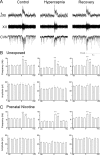
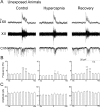
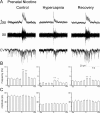
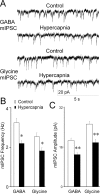
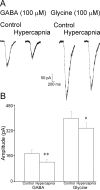
Similar articles
-
Prenatal nicotine exposure alters central cardiorespiratory responses to hypoxia in rats: implications for sudden infant death syndrome.J Neurosci. 2004 Oct 20;24(42):9261-8. doi: 10.1523/JNEUROSCI.1918-04.2004. J Neurosci. 2004. PMID: 15496661 Free PMC article.
-
Prenatal nicotine exposure recruits an excitatory pathway to brainstem parasympathetic cardioinhibitory neurons during hypoxia/hypercapnia in the rat: implications for sudden infant death syndrome.Pediatr Res. 2005 Sep;58(3):562-7. doi: 10.1203/01.PDR.0000179380.41355.FC. Pediatr Res. 2005. PMID: 16148074
-
Nicotinic receptor activation occludes purinergic control of central cardiorespiratory network responses to hypoxia/hypercapnia.J Neurophysiol. 2007 Oct;98(4):2429-38. doi: 10.1152/jn.00448.2007. Epub 2007 Aug 15. J Neurophysiol. 2007. PMID: 17699693
-
Prenatal nicotine exposure and development of nicotinic and fast amino acid-mediated neurotransmission in the control of breathing.Respir Physiol Neurobiol. 2008 Dec 10;164(1-2):80-6. doi: 10.1016/j.resp.2008.05.008. Respir Physiol Neurobiol. 2008. PMID: 18585984 Free PMC article. Review.
-
Role of fast inhibitory synaptic transmission in neonatal respiratory rhythmogenesis and pattern formation.Mol Cell Neurosci. 2019 Oct;100:103400. doi: 10.1016/j.mcn.2019.103400. Epub 2019 Aug 28. Mol Cell Neurosci. 2019. PMID: 31472222 Review.
Cited by
-
Prenatal to early postnatal nicotine exposure impairs central chemoreception and modifies breathing pattern in mouse neonates: a probable link to sudden infant death syndrome.J Neurosci. 2008 Dec 17;28(51):13907-17. doi: 10.1523/JNEUROSCI.4441-08.2008. J Neurosci. 2008. PMID: 19091979 Free PMC article.
-
Prenatal Nicotine Exposure Disrupts Infant Neural Markers of Orienting.Nicotine Tob Res. 2018 Jun 7;20(7):897-902. doi: 10.1093/ntr/ntx177. Nicotine Tob Res. 2018. PMID: 29059450 Free PMC article.
-
Central activation of the A1 adenosine receptor (A1AR) induces a hypothermic, torpor-like state in the rat.J Neurosci. 2013 Sep 4;33(36):14512-25. doi: 10.1523/JNEUROSCI.1980-13.2013. J Neurosci. 2013. PMID: 24005302 Free PMC article.
-
CO2-dependent opening of an inwardly rectifying K+ channel.Pflugers Arch. 2011 Mar;461(3):337-44. doi: 10.1007/s00424-010-0916-z. Epub 2011 Jan 14. Pflugers Arch. 2011. PMID: 21234597 Free PMC article.
-
The role of infection and inflammation in sudden infant death syndrome.Immunopharmacol Immunotoxicol. 2009;31(4):516-23. doi: 10.3109/08923970902814137. Immunopharmacol Immunotoxicol. 2009. PMID: 19874217 Free PMC article. Review.
References
-
- Balfour DJ, Wright AE, Benwell ME, Birrell CE (2000) The putative role of extra-synaptic mesolimbic dopamine in the neurobiology of nicotine dependence. Behav Brain Res 113: 73–83. - PubMed
-
- Bamford O, Carroll J (1999) Dynamic ventilatory responses in rats: normal development and effects of prenatal nicotine exposure. Respir Physiol 117: 29–40. - PubMed
-
- Bamford OS, Schuen JN, Carroll JL (1996) Effect of nicotine exposure on postnatal ventilatory responses to hypoxia and hypercapnia. Respir Physiol 106: 1–11. - PubMed
Publication types
MeSH terms
Substances
Grants and funding
LinkOut - more resources
Full Text Sources
